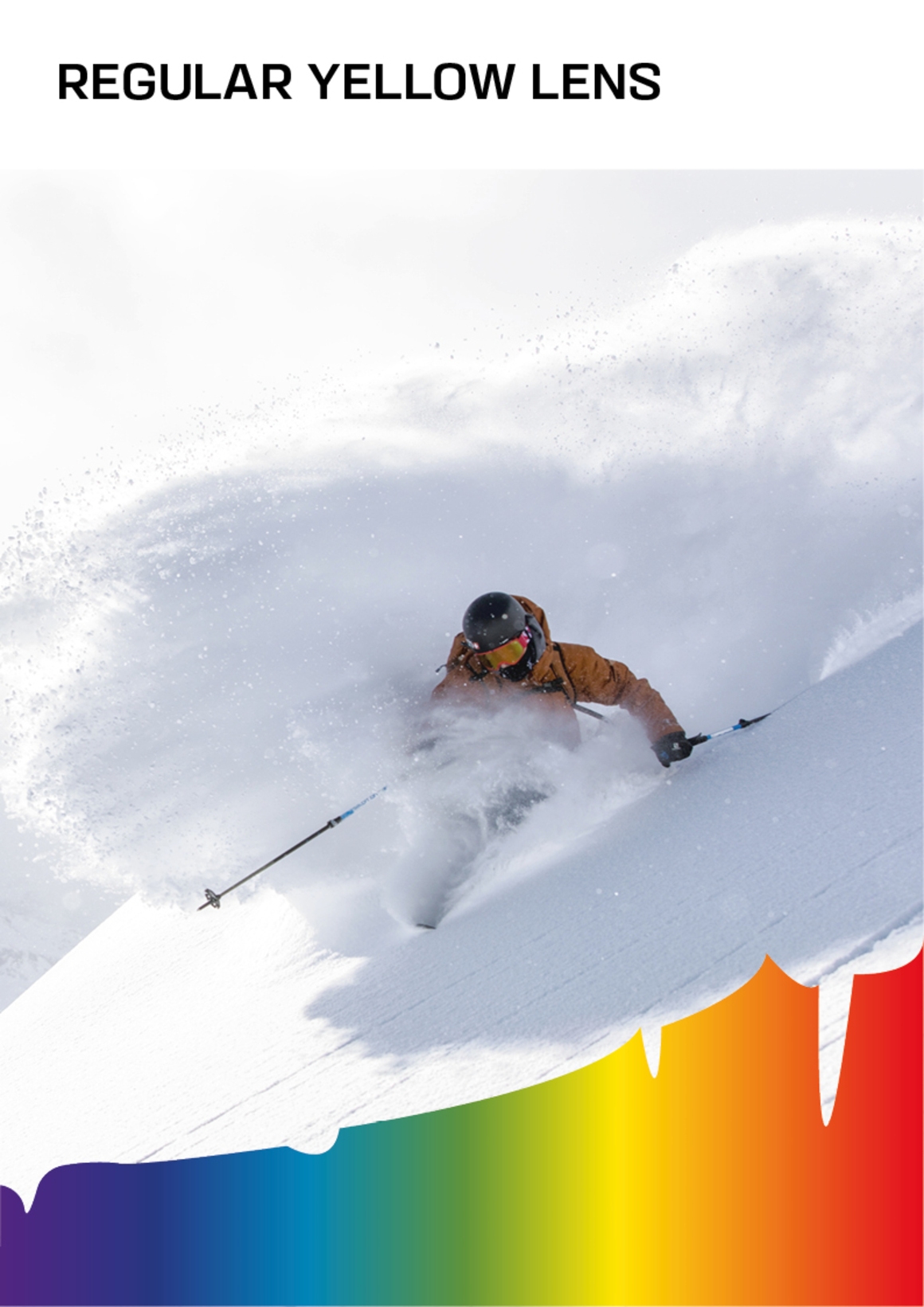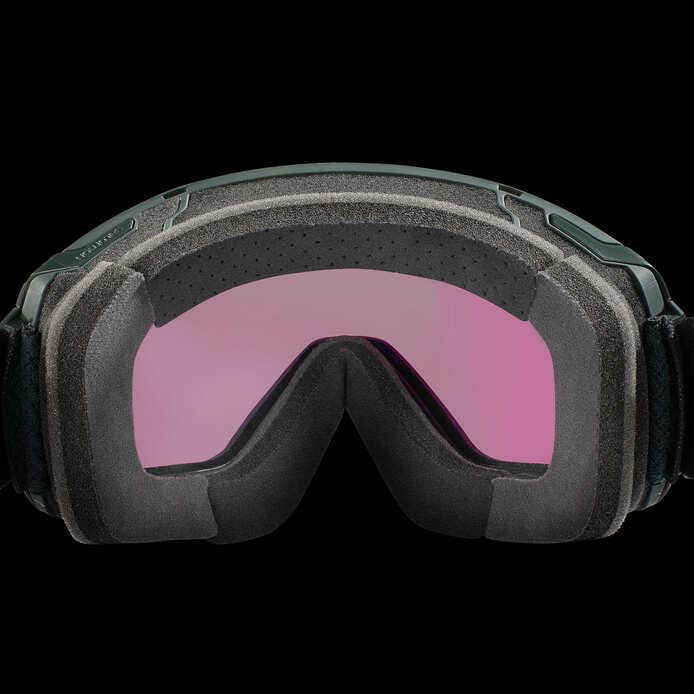In the past ski goggles were only used in bad weather, however nowadays they have become an essential item to protect your eyes in all weather conditions... and they are stylish! The price range is wide and depends on the models and technologies used so it is easy to get confused. In this article you will find all the key advice to help you choose a pair of ski goggles adapted to the shape of your face and the conditions in which you will be using them.
WHY WEAR SKI GOGGLES RATHER THAN SUNGLASSES?
Ski goggles give your eyes and face complete protection while skiing:
Protection against ultraviolet (UV) rays
The ski goggles’ lens prevents damage to your eyes by protecting them from the sun's rays and filtering 100% of the UV rays. This is especially important in the mountains, where the intensity of the sun's rays increases by 10 to 12% for every 1000 meters (3,281 ft) you gain in altitude, and the snow reflects up to 85% of the sunlight. Protecting your eyes is therefore essential.
Light transmission filter
In nice weather, the intensity of the sun in the mountains is very high. To cut glare and reduce eye fatigue you will need a lens that filters bright light.
On the other hand, when the weather is bad, your ski goggles’ lens should let light in (while still filtering 100% of the UV rays) to help you identify terrain variations.
Protection from cold, wind, snow and foreign objects
When sealed properly, ski goggles provide a more efficient barrier around your eyes than sunglasses and protect your eyes from cold and wind while skiing. In bad weather, they also shield your eyes from snow and rain.
If you happen to ski into a tree branch, hit some debris or even worse, the tip of a ski pole, your ski goggles will prove their worth!
WHAT TYPE OF LENS SHOULD I CHOOSE FOR MY SKI GOGGLES?
Ski goggle lenses have improved a lot and can combine several technologies and treatments that increase comfort and optical quality for the user. Of course, the more technologies used on the lens the higher the final price of the ski goggles.
Protection Index
All ski goggles must adhere to the EN174 standard and filter 100% of UV rays which are harmful for your eyes. In addition, the lens 'category' is a rating that's based on the amount of visible light the goggle lens allows to pass through to your eyes (VLT = Visible Light Transmission). In other words, the category refers to the percentage of light that is not filtered out by the lens:


- Category 0: The lens transmits more than 80% of the light. These are ideal for night missions.
- Category 1: The lens allows 43% to 80% of the light to pass through. These are usually slightly dark lenses that are perfect for white out and cloudy days, as well as other conditions with weak light.
- Category 2: Lenses in this category transmit 18 to 43% to the light, and because they are more versatile they work great in mixed conditions and for skiing in shady areas.
- Category 3: These lenses allow 8 to 18% of the light to pass through and are most efficient on sunny days.
- Category 4: Less than 8% of visible light passes through the lens. This category is used for extreme luminosity at high altitudes or on a glacier. The lens is very dark in color.
So it's essential to use a lens that's suited to your current weather conditions. Some goggles come with a second lens included, but if you don't want to invest in an additional lens then an excellent alternative is a photochromic lens.


Photochromic lenses
These lenses are made from pigments that react to the sun's ultraviolet rays. Photochromic lenses automatically adapt to different light conditions by becoming darker or lighter with a range from category 1 to 3.
Lenses using this technology are more expensive than normal lenses and have become increasingly popular with skiers and snowboarders. They are very practical on the mountain as having a photochromic lens enables you to wear a single pair of goggles with the same lens regardless of the weather.
Lens tint
Other than appearance, lens tint allows your goggles to adapt to different light conditions and improves your perception of the environment:
- Pink, yellow and orange tint: improves contrast and accentuates depth perception making variations in terrain more visible, particularly in bad weather. Pink and orange tints are more versatile and can also be used in mixed weather conditions.
- Brown or gray tint: provides true color perception and improves visual acuity. They are perfectly adapted to strong light conditions.
Colored coating
The coating gives a color to the lens and provides the skier with more visual comfort by reducing glare. However, these lenses are more fragile.
The latest technologies include pigments and enhanced contrast that helps you read every detail of the terrain. This technology is used in Salomon's Sigma range.


Polarized lenses
These lenses reduce the amount of glare from light reflecting off the snow but might make icy patches harder to see.


Anti–fog coating
Nowadays, the majority of ski goggles come with a double-layered lens which reduces fogging. As with double glazing on windows, the inside of the goggle lens is isolated from outside cold, which prevents fog from forming. In addition, the ventilation foam that surrounds the frame provides optimal ventilation.
Anti-fog coating is effective on the inside of the goggles. Try not to touch the inside of the goggles if they are wet as you might rub the coating off. A waterproof coating on the outside prevents snow and water from settling on the lens.
Scratch-resistant coating
This increases the life span of your lens.
Cylindrical or spherical lenses?
There are two lens shapes: cylindrical and spherical.
- Cylindrical lenses are flat, 2D and give you a wide horizontal field of vision and reduce optimal distortion. Skiers like their vintage style.
- Spherical lenses are made using a sphere, they are 3D and give you wide horizontal and vertical fields of vision.


SKI GOGGLE STRUCTURE
Lens quality is an important factor to consider when purchasing your goggles, along with how they are structured as this affects their comfort and shape. The structure includes different elements such as the frame clip, foam padding, the strap and defines whether there is the possibility to change the lenses.
Lens rim
There are 3 distinct types of rim:
- Full-frame: the goggle structure is visible and surrounds the lens.
- Frameless: the lens covers the goggle structure. The field of vision is maximized and changing the lens is facilitated due to an integrated system.
- Semi-frameless: some parts of the frame are visible on the sides of the lens


Over the glasses (OTG)
Some ski goggles can be worn on top of your prescription glasses. They are deeper, the frames have openings on the sides and there is a space in the foam to accommodate the arms of the glasses on the side of the goggles.


Foam
There are 2 types of foam found on ski goggles:
- Ventilation foam: found on the goggle's rim, it helps air circulate within the goggles to prevent them from fogging and the foam also stops snow and rain from getting in.
- Foam padding: this padding sits against your face and makes the goggles comfortable to wear. There are different densities that are made from soft materials and reduce perspiration.


Magnetic lens goggles
Some goggles are equipped with magnets strategically positioned on the frame and/or lens which makes lens management super efficient. Magnetic lens goggles are often sold with two lenses of different categories so you can adapt to changes in the weather by quickly and easily swapping the lenses. A few models feature a system that locks the lens to the frame for additional security, which is especially useful in case of a fall.
Strap
Another big factor in determining the comfort of your goggles is the strap. It provides a solid connection between the goggles and helmet thanks to a grippy silicone bead on the inside of the strap. There are usually two plastic pieces on the strap that are used to adjust the size.
It is important to try your ski goggles on before buying them to make sure that they are the right size and shape. There are specific models for women and children which suit thinner faces. For your comfort, make sure your goggles are compatible with your ski helmet.
Ski goggles are an integral part of your ski wear, they help you look the part and feel comfortable.
Prices vary depending on the technologies used and it can be tempting to go for the least expensive model. Budget goggles provide you with baseline protection when on a skiing holiday, for example, in a resort or if you only ski occasionally. If you spend a lot of time on your skis, investing in a good pair of goggles with two lenses or a photochromic one will protect your eyes and give you additional comfort that you won't regret!














